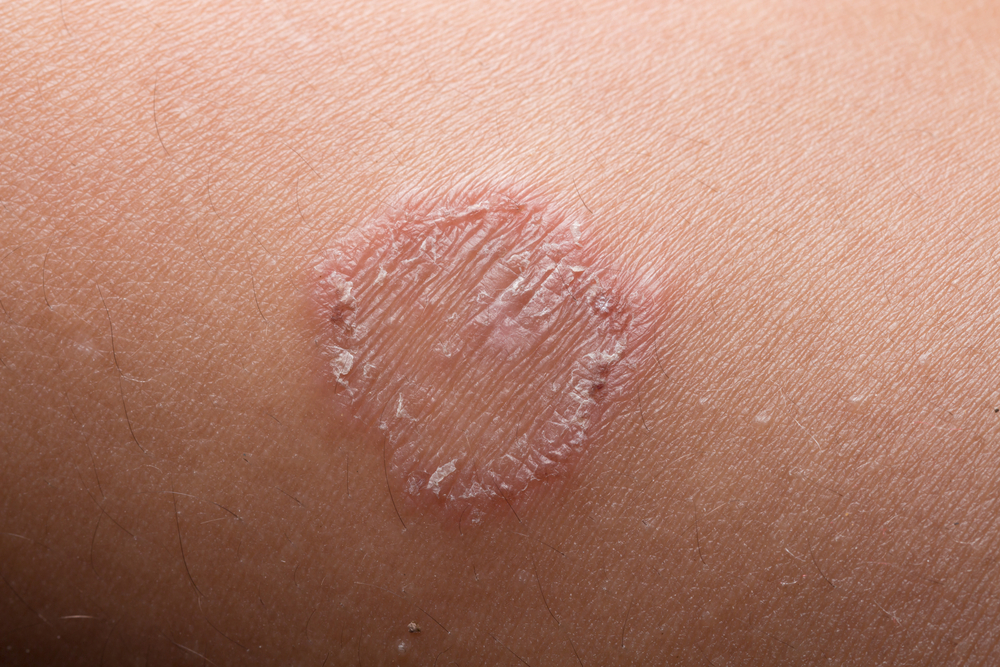Ringworm is a skin condition that is actually not related in any way to worms.
In fact, ringworm is a fungal skin infection caused by group of fungus called dermatophytes.
How did my child catch it ringworm?
Ringworm affects both us and animals and is very contagious.
You can catch ringworm from coming into contact with an infected person or animal, a contaminated surface, item or object. This could be a playground, gym equipment, contaminated clothing, towels, sheets, bath mats, shower floors…
It can affect different areas of the body- the skin, scalp, groin, feet and nails. The fancy scientific names area as follows:
- Tinea corporis affects the skin excluding the hands and feet, scalp, face and beard, groin, and nails.
- Tinea capitis affects the scalp
- Tinea pedis affects the feet (aka athlete’s foot)
- Tinea cruris affects the groin (aka jock itch)
- Tinea unguium affects the fingernails and toenails
What can ringworm look like?
Depending on the area affected, ringworm will look different.
Ringworm on the skin and groin is the classic ring-shaped, flat, scaly rash that, as becomes more prominent, will appear as a raised, red and itchy ring with a clearer middle.
Ringworm on the feet is not the classic ring-shaped rash. It generally appears between the toes as dry, cracked skin that can be quite itchy. It can worsen with more larger areas of the foot becoming affected as it spreads form the original spot.
Ringworm on the scalp begins as a little pimple that grows bigger and causes dry, scaly patches of bald skin. It can become crusty and if left untreated, can start to ooze pus and cause hair loss.
Ringworm can also affect the fingernails and toenails by infecting the nailbed causing nails to become thick, brittle and discoloured.
What can make my child more susceptible to ringworm?
It can be really easy for children to catch ringworms simply due to the close contact they generally have with other in their environment.
Living somewhere where humidity levels are high or high for a longer period of the year can add to this burden as warm, moist environments are where these fungi thrive.
Some children can be more prone or more likely to endure stubborn or chronic cases if they:
- Suffer from other chronic skin conditions such as xerosis and eczema. These children already have compromised skin barrier functions and reduced skin immune defences against pathogenic bacteria and fungi.
- Have poor nutritional status that compromises their immune function. This may be due to their dietary pattern, their overall digestive capacity and/or ability to absorb nutrients.
- Have a dysbiotic gut. Having imbalances in beneficial bacteria, unfavourable and/or pathogenic microbes can affect the gut-skin axis. Simply put, whatever is making the gut unhappy can lead to increased inflammation and breakdown in immune defences in the skin.
What can I do at home?
If your child has a ringworm infection, it is important to take measures to prevent spread, not only to other people but also to other areas of your child’s own body. Care in preventing spread will need to take into consideration where the infection is. Here are some general tips:
- Apply a topical anti-fungal treatment (our favourite natural topical cream options include ones with thuja or tree essential oil)
- Cover the ringworm with a band-aid
- Avoid sharing baths with others
- Dry body thoroughly after a shower/ bath- particularly in areas of the body that are often missed and left to air-dry such as in between the toes, armpits and groin
- Avoid sharing brushes, combs, hats, clothing, linen, towels
- Change towels, clothing, underwear, pyjamas daily
- Wipe down any surfaces or items diligently that may have come into contact with the ringworm infected skin
- Support your child’s immune system. Check out my tips here
- Add garlic to the diet where you can- think raw garlic crushed into a salad dressing, guacamole, humus or other kins of dips. Garlic has anti-fungal and anti-dermatophyte activity.
Need support?
If you are struggling to get ringworm infections under control in your child, book in with one of our practitioners today. You will be provided with a comprehensive assessment of factors that may be contributing to the infection in your child and then a tailored treatment plan to work towards resolution of the infection once and for all.




